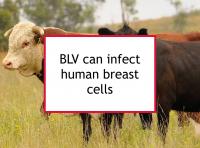Exposure to bovine leukemia virus (BLV) is suspected to be a risk factor for breast cancer. BLV is a retrovirus that causes enzootic bovine leucosis in beef and dairy cattle. BLV infects the majority of animals in U.S. herds but normally does not cause obvious illness. Often only clearly ill animals are culled. Now a new study has demonstrated that BLV can successfully infect breast cells.
BLV and breast cancer
Links between viral infection and cancer have been established for a number of viruses, among them hepatitis B and hepatitis C (liver cancer), human papilloma virus (HPV) (cervical cancer), human T lymphotrophic virus type 1 (HTLV-1) (T-cell leukemia), and Epstein-Barr (B and T cell lymphomas, Hodgkin’s disease, and other cancers). BLV is a retrovirus closely related to HTLV-1.
It can take years or even decades for infection with an oncogenic virus to result in cancer, and only a minority of those infected will actually progress to cancer. This is because viruses do not appear to cause cancer directly, but may induce a tissue microenvironment that is supportive of cancer initiation or growth. For example, in some cases, viral gene products in tumor cells can help them maintain their excessive proliferation. As such, a relevant viral infection can be thought of as a cancer risk factor rather than a trigger that inevitably causes cancer.
Several studies have reported that breast cancer patients are more likely to have BLV DNA in their breast tissue at diagnosis than women without a history of breast cancer. One study reported that the BLV in breast tissue did not appear to be in its usual latent state in some infected women, indicating that viral replication could be occurring. On the other hand, other studies have reported no association between BLV and breast cancer.
Avoiding exposure to BLV
Uncooked beef is a possible source of BLV exposure and infection. It is not clear to what extent handling raw beef during cooking (such as in making meatballs or preparing steak for grilling) could transmit the virus. However, it makes sense to use the same precautions in handling raw beef that are currently recommended for raw chicken. Tasting raw ground beef mixtures during cooking preparation or consuming beef "rare" or as steak tartare could introduce risk of BLV infection. Raw milk is another possible source (pasteurization destroys the virus).
Latest research finds BLV can successfully infect breast cells
The study referenced above was designed to investigate the potential link between BLV and breast cancer. BLV causes persistent infections in animals, most of which remain asymptomatic. However, some develop lymphosarcoma. Previous studies have reported detection of BLV proviral DNA in milk and beef, as well as antibodies and proviral DNA in humans, suggesting possible zoonotic (animal to human) transmission.
To conduct the study, the authors devised a model of natural exposure by infecting normal breast cells (MCF-10 A) with BLV under controlled conditions. They also evaluated the effect of the estrogen 17-β estradiol (E2). BLV was found to integrate its DNA into the breast cells. Furthermore, the proviral load increased in the presence of the estrogen, suggesting that E2 enhanced viral integration.
The virus replicated successfully in the breast cells and produced virus particles capable of infecting bovine mammary cells. The authors comment that the findings suggest BLV could establish infections in human breast cells under certain conditions, potentially contributing to breast cancer development. This highlights the importance of food safety practices, particularly regarding raw milk consumption, according to the authors. Further research is needed into BLV's zoonotic potential.
